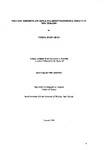VOLCANIC EMISSIONS AND DISTAL PALAEOENVIRONMENTAL IMPACTS IN NEW ZEALAND
| dc.contributor.author | GILES, TERESA MARY | |
| dc.contributor.other | School of Geography, Earth and Environmental Sciences | en_US |
| dc.date.accessioned | 2013-10-11T10:25:28Z | |
| dc.date.available | 2013-10-11T10:25:28Z | |
| dc.date.issued | 1999 | |
| dc.identifier | NOT AVAILABLE | en_US |
| dc.identifier.uri | http://hdl.handle.net/10026.1/2176 | |
| dc.description.abstract |
This thesis is a palaeoenviromnental investigation into possible non-climatic effects on the environment from volcanic ash fall and toxic emissions outside the blast zone of a volcanic eruption. These effects are determined from palynological and geochemical changes following tephra fall at a range of sites across the North Island of New Zealand which were located at increasing distances from the main volcanic source, the Taupo Volcanic Zone. These sites collectively covered a wide variety of habitats existing under different climatic regimes. The first site is a peat bog at a warm temperate, comparatively unstable coastal location, Matakana Island. The peat profile extends to 1000 yrs BP and contains the Kaharoa Tephra layer, erupted around the time of early human settlement in New Zealand. The second study site is Kaipo peat bog which, in contrast to Matakana Island, is an upland sub-alpine site existing under a harsher climatic regime with cool temperatures, strong winds and heavy rainfall. The Kaipo record covers the Holocene period up to recent times. Lake Rotoroa is the third site which is located inland, sheltered within the Waikato valley, an area of rich fertile soils and mild temperate climate. The Lake Rotoroa record extends to approximately 15,000 yrs BP including the end of the last glacial period and the Holocene. The final site investigated, Kohuora bog, is situated in an extinct late Quaternary volcanic crater within Auckland urban area, a region of warm temperate climate. This record extends from the last glacial period to the present. Fine resolution sampling methods were employed above tephra layers preserved at each of these sites to examine the immediate short-term palaeoenvironmental impacts from volcanic tephra deposition. The methods used included pollen analysis, and the relatively new technique of Energy Dispersive X-ray Micro Analysis (EDMA) which investigated changes in sediment geochemistry to provide further information on local environmental change following tephra impact. The use of pollen analysis together with EDMA proved beneficial in assessing overall short term environmental impacts from tephra fell. Results revealed that thicker tephra layers did not always cause extensive environmental damage, as impacts seen above the 0.5 cm thick Egmont 15 Tephra at Lake Rotoroa were among the most significant recorded at this site. Instead, the contributing factors of prevailing climate and local site factors (e.g. drainage, soils, vegetation cover and shelter) at the time of an eruption, together with local forest diversity and species sensitivity to tephra deposition, proved more important in determining the degree of tephra impact. Taxa found to be particularly sensitive to tephra deposition included Halocarpus, with inconsistent impacts from tephra fell on Dacrydium and Metrosideros. Duration of tephra impacts varied between sites, but broad estimates from the results showed the time taken for recovery of forest vegetation following an eruption was >100 years, with environmental stability returning after a minimum period of 50 years. The results from Matakana Island revealed that any possible tephra impacts from deposition of the Kaharoa Tephra were obscured owing to large-scale deforestation following Polynesian settlement on the island around the time of the Kaharoa eruption. This study indicates the importance of investigating distal volcanic impacts prior to human settlement to eliminate ambiguity in interpretation of palaeoenvironmental data. | en_US |
| dc.description.sponsorship | University of Waikato, New Zealand | en_US |
| dc.language.iso | en | en_US |
| dc.publisher | University of Plymouth | en_US |
| dc.title | VOLCANIC EMISSIONS AND DISTAL PALAEOENVIRONMENTAL IMPACTS IN NEW ZEALAND | en_US |
| dc.type | Thesis | |
| dc.identifier.doi | http://dx.doi.org/10.24382/3398 | |
| dc.identifier.doi | http://dx.doi.org/10.24382/3398 |
Files in this item
This item appears in the following Collection(s)
-
01 Research Theses Main Collection
Research Theses Main


